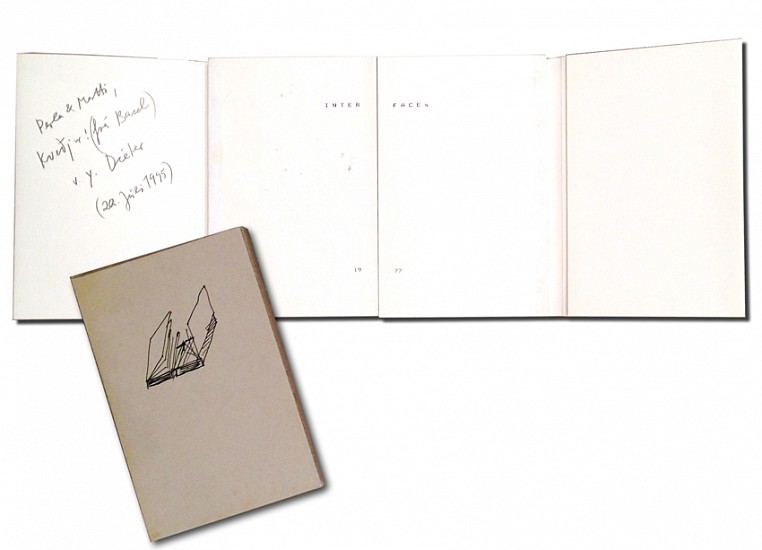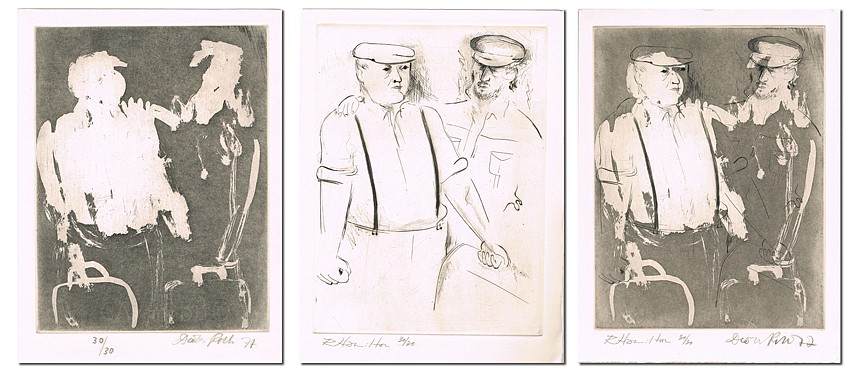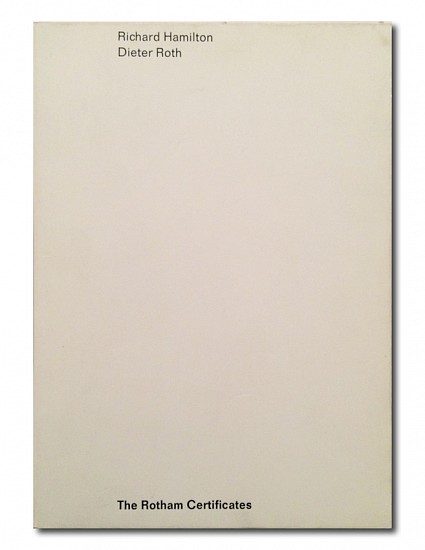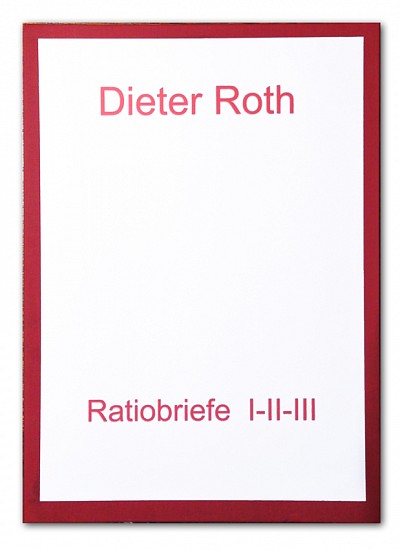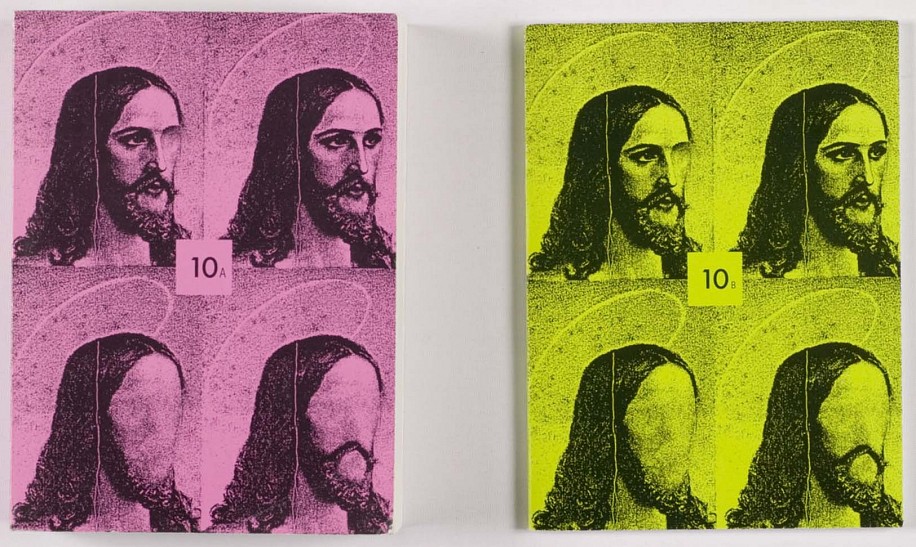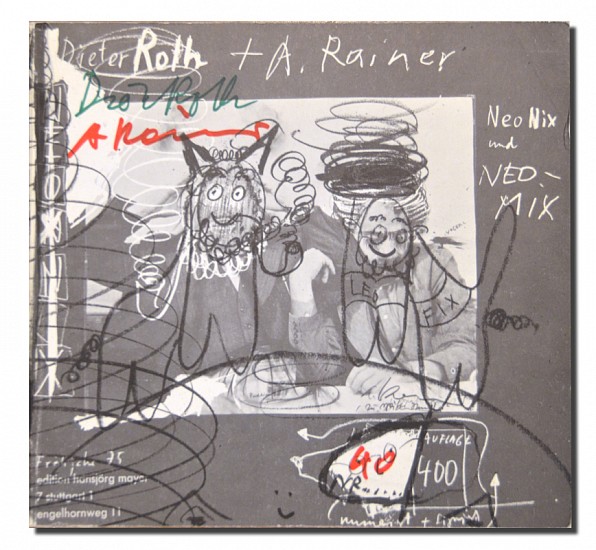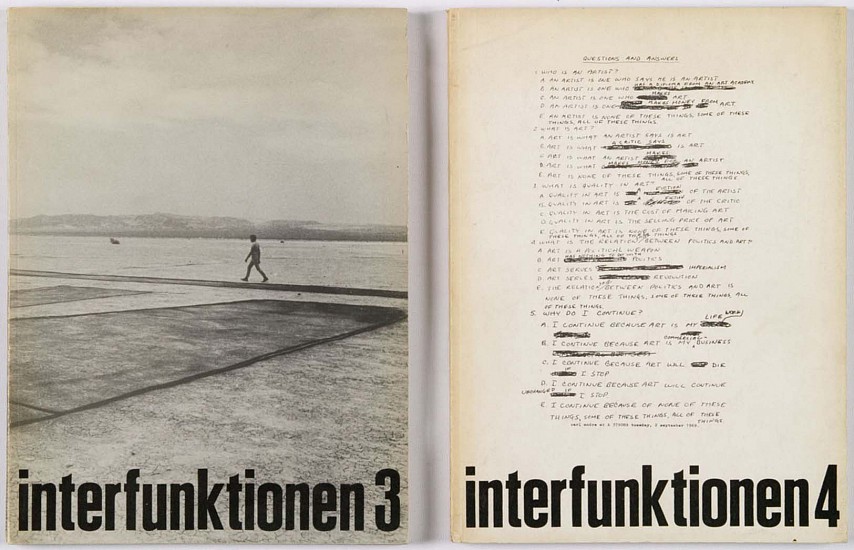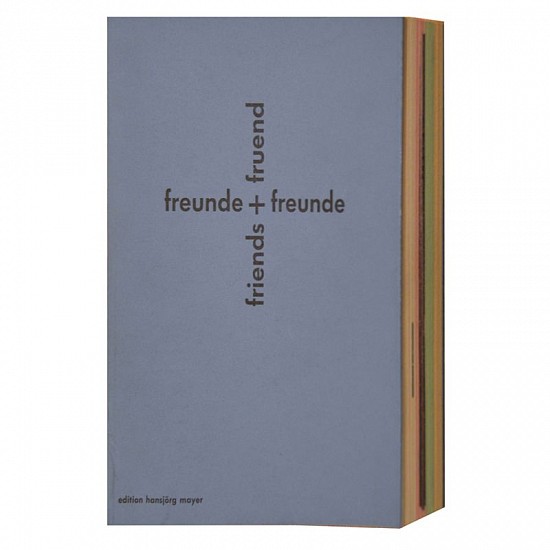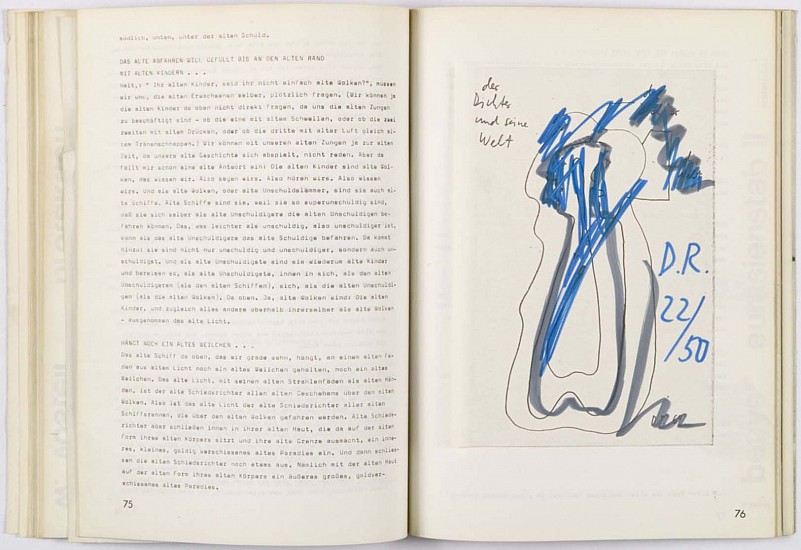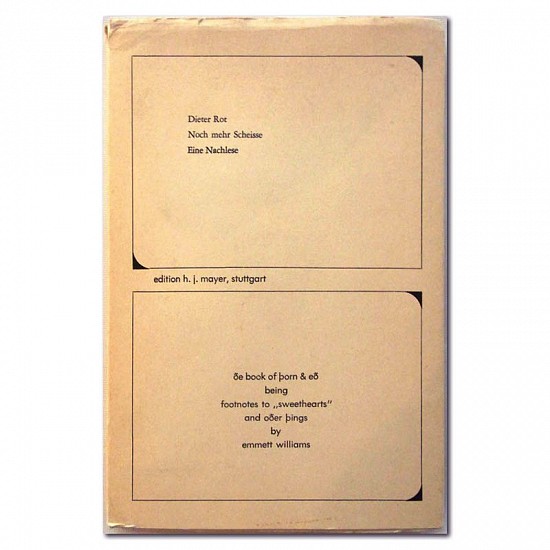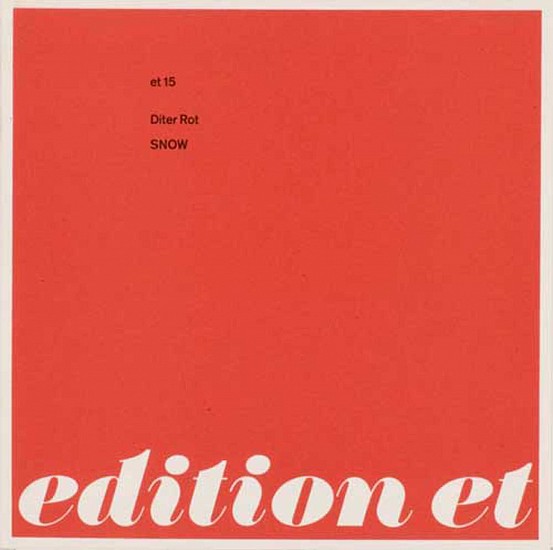Collaboration Roth
Collaboration Roth
Interfaces, 1988
3400-BK
7 1/8 x 4 3/8 in. (18 x 11 cm)
This artist book is a butterfly bound book with images of pieces by Richard Hamilton and Dieter made for the exhibition in Cadaques Spain. This is one of 500 copies with inscription dated 1995 plus a drawing of the book on the box. NOT IN ROTH.
Price Upon Request
Collaboration Roth
Double Portrait tripdic, 1977
4044-BK
9 x 6 3/4 in. (23 x 17 cm)
Roth, Dieter and Hamilton, Richard. Drypoint, Aquatint, Drypoint and Aquatint within the DELUXE EDITION Collaborations of CH. Rotham. 128 pages, offset and letterpress. 72 color plates. 23 X 17 cm, stitched, softback. Printed by Staib + Mayer, Stuttgart. Published by edition Hansjorg Mayer, Stuttgart, London, and Galeria Cadaques (Gerona). 2000 copies of which 30 in leather and slipcase, with 3 etchings by the authors, numbered and signed. This is the copy n 30 of 30 . DR. CW. 40 # 95.
Price Upon Request
Collaboration Roth
The Rotham Certificates with Richard Hamilton, 1977
4343-BK
5 7/8 x 4 1/8 in. (15 x 10.5 cm)
37 postcards and introduction in folded cover, offset, multicoloured. 14.8 x 10.5 cm, in cover, printed by Staib + Mayer, Stuttgart. Published by edition hansjorg mayer, Stuttgart, und Galeria Cadaque (Gerona). Edition of 1000 . DR. CW. 40 # 96.
Price Upon Request
Collaboration Roth
Ratiobriefe with Arnulf Rainer, 1976
4344-BK
11 3/4 x 8 1/4 in. (29.7 x 21 cm)
Radio Letters 1,2,3 complete all issues stapled and in cloth portfolio in an edition of 200 copies.Ratioletter 1, 3 sheets. Ratioletter 2, 5 sheets. Ratioletter 3, 23 sheets. Small offset, stapled. Published by edition hansjorg mayer, stuttgart, Iondon, reykjavfk, edition of 200 each . DR. CW. 40 # 94.
Price Upon Request
Collaboration Roth
Zeitschrift fur alles Review for Everything, 1975-78
1175
10 volumes in all with covers designed by Uwe Lohrer, between 32 and 1252 pages offset, softback, staples or adhesive bound. Nos. 1-3, edition Hansjorg mayer 1975-78, then Dieter Roth's Verlag(Nos. 8-10 edited by Barbara Wein, Berlin) NOt in DR. CW. 23x17cm
Price Upon Request
Collaboration Roth
Neo Nix und NEO MIX, 1975
3429-BK
9 x 9 7/8 in. (23 x 25 cm)
Dieter Roth and Rainer. 240 pages, offset, multicolored, stitched, softback. Printed by Staib + Mayer, Stuttgart. Published by edition Hansjorg Mayer, Stuttgart, London, Reykjavik. 400 copies, numbered and signed by both authors. This is the copy n 40 of 100 . DR. CW. 40 # 92.
Price Upon Request
Collaboration Roth
Interfunktionen 4, 1970
1114
11 5/8 x 8 5/8 in. (29.5 x 22 cm)
183 pages of witch 8 by Rot. Periodical, Pictorial wrapper. Offset printed. Glue bound. Black and white. Edition of 1100. Published by F.W. Heubach, Cologne.Offset and collage element. 29.5 x 22 cm (11 5/8 x 8 11/16 in.)Cologne. Artists and contributors included: Panamarenko, Dennis Oppenheim, Keith Arnatt, Joseph Beuys, Daniel Buren, Diter Rot [Dieter Roth], Claus Böhmler, Günter Brus, Gilbert & George, Dieter Meier, Jan Dibbets, F. W. Heubach, Daniel Buren, Peter Weibel, Paul Sharits, W & B Hein, Valie Export, Carl Andre. Twelve issues over seven years( 1968-1975) may not appear to be a particularly impressive output, but it is difficult to overemphasise the influence and significance of Interfunktionen during and after its brief existence. Dissenting from the new 'art-as-commodity' attitude expressed at Arnold Bode’s documenta 4, Interfunktionen magazine, edited by Fritz Heubach in Cologne, was an interdisciplinary effort among activist artists to promote European art and ideas without bowing to the era’s increasingly commercial trends. In the summer of 1968 the opening of Documenta 4 had come under public attack for a conventional, market-driven agenda that was felt to represent inadequately the art of the '60s. With the exception of some "environments" neither space nor money was available for new media: an event involving performance and sound art, long planned by Wolf Vostell, was cancelled. American Pop and Minimalist artists, hot tickets on the German art market, far outnumbered artists from any single European country, provoking critics to nickname the show "Americana" and to refer to New York City as a "suburb of Kassel." Inextricably linked with the Joseph Beuys-era Kunstakademie Düsseldorf and the LIDL Akademie, Interfunktionen boasted contributions and support from Jörg Immendorff, Sigmar Polke and Wolf Vostell. It published theory, criticism and artists’ projects, and facilitated a brand of European-American relations in art that had not quite existed or been explored before. Interfunktionen’s first issue was originally published in – by today’s standards – an impossibly small edition of 120 (later issues averaged a circulation of about a thousand, although issue 2 was produced in an edition of only 250, with issue 3 in an edition of 300). Sets of the magazine with the original edition of issue no.1 are exceedingly rare. This first number's main function was to articulate a reaction to documenta 4: the record of a performance action staged by a loose group of Interfunktionen members and supporters at the press conference and the reproduction of pieces banned at the exhibition. The first issue is a collection of some seventy-five pages, made of assorted papers printed, typed, or handwritten, including loose enclosures, foldouts, and collages of news clippings with scrawled citations. In his introduction, Heubach warns that the restrictive policies of art institutions like Documenta impede the free, experimental production of art. Detailed records describing the canceled multimedia event and a general collection of news coverage follow. Midway through the issue things heat up. "Honey-Blind Action" documents performances staged by artists during the opening press conference of Documenta: Jorg Immendorff jumped across tables, waved a stick topped with the silhouette of a cute polar bear painted light blue, and smeared honey over the microphones, while his wife, Chris Reinecke, "hugged and kissed everyone," including the alarmed curator Bode. Vostell poured a bag of change in front of the curators as a symbolic donation, and Heubach, among others, raised a banner reading, "Prof. Bode, we, the blind, thank you for this pretty show." Newspaper articles are interspersed with an absurd correspondence between Reinecke and the city of Kassel, which officially fined her 27.35DM for the removal of honey stains from tables and carpets. Matching the city's bureaucratese, her formal reply declined responsibility and requested that the bill be sent to her husband instead at the same address. The "
Price Upon Request
Collaboration Roth
Freund + Friends + Freunde + Freunde, 1969
3473-BK
9 x 6 3/4 x 78 in. (23 x 17 x 2.3 cm)
Roth, Dieter, Karl Gerstner, Daniel Spoerri, Andre Thomkins und Freunde. Artist's book published in conjunction with exhibition held at Kunsthalle Bern, Bern, Switzerland, May 1969. Traveled to Kunsthalle Düsseldorf, Düsseldorf, Germany, July 1969. Contributions from Karl Gerstner, Dieter Rot [Dieter Roth], Daniel Spoerri, Andre Thomkins, and "friends." Composed of drawings and reproduced texts. Texts in German. Reference : No. 391 in "Die Bücher der Künstler : Publikationen und Editionen seit den sechziger Jahren in Deutschland" by Michael Glasmeier. London / Frankfurt, United Kingdom / German : Institut für Auslandsbeziehungen, 1994, pp. 164.
Price Upon Request
Collaboration Roth
Interfunktionen 3, 1968
1125
11 5/8 x 8 5/8 in. (29.5 x 22 cm)
146 pp., Periodical, Pictorial wrapper. Offset printed. Glue bound. Black and white. Edition of 500. edited by Friedrich Wolfram Heubach.Published by F.W. Heubach, Cologne. Artists and contributors included : Joseph Beuys, Walter de Maria, Dennis Oppenheim, Mike Heizer, Richard Long, Jan Dibbets, Robert Smithson, Friedrich Wolfram Heubach, Lutz Schirmer, Hagen Lieberknecht, Wolf Vostell, Diter Rot [Dieter Roth], Johannes Stüttgen, Matthias Schäffer, Gabor Altorjay, Günter Brus, James Lee Byars, LIDL, Jörg Immendorff. With an original unique piece from each artist, including a slice of bread from Vostel and an orginal drawing by Roth.
Price Upon Request
Collaboration Roth
Noch mehr Scheisse, 1968
3434-BK
8 7/8 x 5 7/8 in. (22.5 x 15 cm)
Roth and Emmett Williams. dieter rot still more shit a supplement, Emmet Williams footnotes to sweethearts. 100 pages letterpress. stitched softback dustjacket. Printed by Prentsmioja Jons Helgasonar reykjavik. Published by edition Hansjorg Mayer Stuttgart. 500 numbered and rubber stamp signed copies.Photomechanischer Nachdruck, (Ranier Edition) nd. Offset printed book, paper, revised edition. This is teh copy number 76 of 500, Signed and dedicated to Jons Helgasonar in 1968. DR. CW. 20 # 36.
Price Upon Request
Collaboration Roth
Edition et, Complete set vols 1-4 and 13-15 all published, 1966-67
1111
9 x 9 in. (23 x 23 cm)
Polke, Richter, Roth and many others. 7 volumes in all. Square portfolios with many original graphics from artists of the period. The first 4 volumes,1-4, have 20 or more artists per volume and the last 3 , 13-15, are one artist only. Rot made graphics Nummern-Malwerk on pink paper for Volume 3, Bildmaterial fur et Nr.2 for Volume 2, and for volume 15 made an artist book titled SNOW with 96 reproductions of photographs and hand written translations by the author from 'snow'(unique book now in MOMA collection) Introduction by Daniel Spoerri. DR. CW. 20 # 33. 23x23cm
Price Upon Request












